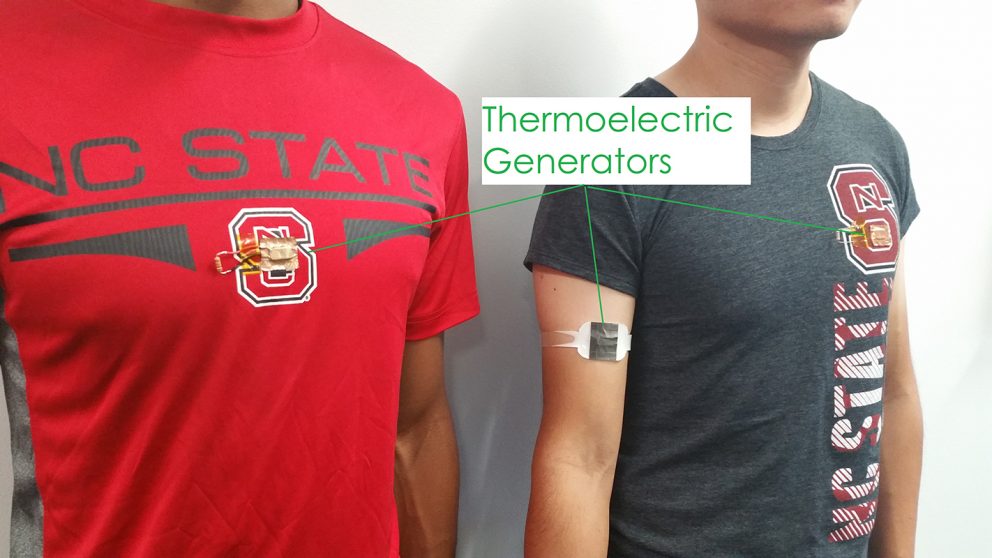
[Image above] North Carolina State University researchers developed a new design for harvesting body heat and converting it into electricity for use in wearable electronics. The experimental prototypes are lightweight, conform to the shape of the body, and can generate far more electricity than previous lightweight heat-harvesting technologies. This image shows the technology embedded in a T-shirt (left) and armband (right). Credit: North Carolina State University
As predicted at the Consumer Electronics Show held in Las Vegas in January, next-generation wearables continue to trend in a big way this year.
And the goal seems to be twofold: create wearables with such mass-market aesthetic appeal that consumers will actually want to wear these devices, but also make them thinner with more flexibility and enhanced efficiency.
From high-tech smart fashion to bracelets that track your mood to the newest augmented reality devices, wearables are getting more sophisticated. The latest technologies debut features like low-energy Bluetooth, cloud computing, 3-D printing, and flexible membranes that will transform this market.
With such developments as wearable displays that are “thin as skin” with novel transparent oxide thin-film transistors and wearable sensors that monitor health through perspiration, researchers are leveraging the latest technology and advanced materials to make wearables work harder for us.
This week, researchers at North Carolina State University (Raleigh, N.C.) have developed a new design for harvesting body heat and converting it into electricity for use in wearable electronics.
The team’s experimental prototypes are lightweight, conform to the shape of the body, and “can generate far more electricity than previous lightweight heat harvesting technologies,” according to a university press release.
“Wearable thermoelectric generators (TEGs) generate electricity by making use of the temperature differential between your body and the ambient air,” says Daryoosh Vashaee, author of the study who worked on the project as part of the National Science Foundation’s Nanosystems Engineering Research Center for Advanced Self-Powered Systems of Integrated Sensors and Technologies (ASSIST) at NC State. “Previous approaches either made use of heat sinks—which are heavy, stiff, and bulky—or were able to generate only one microwatt or less of power per centimeter squared (µW/cm2). Our technology generates up to 20 µW/cm2 and doesn’t use a heat sink, making it lighter and much more comfortable.”

The tech can be embedded in a T-shirt, as shown here on co-lead researcher Haywood Hunter, an undergraduate at NC State. Credit: Daryoosh Vashaee; North Carolina State University
What makes this design concept work is the layer of thermally conductive material that rests on the skin and spreads the heat out, the release explains. A polymer layer tops the conductive material to curb any heat dissipation into the surrounding air. This setup forces the body heat to instead pass through a centrally located TEG that is 1 cm2.
As for the heat not converted into electricity? That passes through the TEG into an outer layer of thermally conductive material that quickly gets rid of excess heat. And the whole system is super-thin (2 mm), flexible, and has major scalable potential.
“In this prototype, the TEG is only one centimeter squared, but we can easily make it larger, depending on a device’s power needs,” explains Vashaee.
When put to the test, the team found that the upper arm was the optimal location for heat harvesting. Other areas tested included the wrist and chest.
“Although body temperature is higher around the wrist, the irregular contour of the wrist limited the surface area of contact between the TEG band and the skin. Meanwhile, wearing the band on the chest limited air flow—limiting heat dissipation—since the chest is normally covered by a shirt,” the release explains.
The team also integrated the TEG system into T-shirts to test viability and found that the T-shirt TEGs could actually generate 6 µW/cm2—or as much as 16 µW/cm2—if the person wearing the shirt was running.
“T-shirt TEGs are certainly viable for powering wearable technologies, but they’re just not as efficient as the upper arm bands,” says Vashaee.
Regardless of the type of wearable used to house the TEG system, Vashaee says the most important factor is that the device isn’t reliant on batteries.
“The goal of ASSIST is to make wearable technologies that can be used for long-term health monitoring, such as devices that track heart health or monitor physical and environmental variables to predict and prevent asthma attacks,” explains Vashaee. “To do that, we want to make devices that don’t rely on batteries. And we think this design and prototype moves us much closer to making that a reality.”
The study, published in Applied Energy, is “Wearable thermoelectric generators for human body heat harvesting” (DOI: http://dx.doi.org/10.1016/j.apenergy.2016.08.150).
